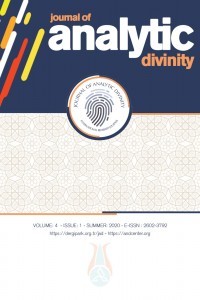Sûf Hareketi Açısından Mescid-i Aksâ ve İsrâ’nın İrfânî Boyutu
Kudüs’ün zühd/sûf hareketi tarihinde özel bir yeri vardır: Burası, İbrahim Halilullah’ın yeri, peygamberlerin diyarı, Zühd peygamberi İsa'nın şehridir. İbn Abbas’a göre Beyt’ü-l Mukaddesi, Peygamberler bina ettiler ve buraya yerleştiler. Şehir, Filistin'in başkenti olarak İslami dönemden itibaren semavi geleneklerin ve medeniyetlerin buluşma yeri oldu. Müslümanlar, Kudüs'e bağlılıklarını, onu himaye ederek gösterdiler. Peygamberlerin yanı sıra diğer semavî gelenekler arasında da ayrım yapmadılar. Kudüs’ün kadim eserlerinden biri kuşkusuz Süleyman Mescidi'dir. Kubbetu’s-Sahra da buradadır. Mescid’in mihrabı üzerinde; "Biz seni yeryüzüne halife kıldık, insanlar arasında hak ile hükmet" yazılıdır.Evliya Çelebi Seyahatnâme’de Kudüs'ü anlatır. Mi’râc yeri, ilk kıble, ziyaretgâh, nefis tezkiyesi, kalp tasfiyesi yapılan bir ibadetgâh olduğundan söz eder. Ona göre; Rabiatu’l-Adevîyye, Gazâlî, İbn'ül Arabî gibi çokça ilim-düşünce önderinin yolu Kudüs'e düşmüştür. Kudüs hâlâ fukarânın (mutasavvıflar) Kâbesi'dir. Şehrin duvarları İran'ın Kahkaha Kalesi gibidir, mimarisi ise olağanüstüdür. Öyle ki, Hz. Süleyman Mescid-i Aksa'yı adeta devlere, insanüstü varlıklara yaptırmıştır. Kudüs, sûf hareketi için neden bu kadar önemlidir? İşte çalışmamızda mi’râc hadisesinden yola çıkarak insanın benlikten Allah'a yolculuğunu, özgürlüğü için masivadan sıyrılıp Allah'a yaklaşmasını ve tevhidi ikame etmesini ele alacak, bilimsel yöntemle konuyu analiz ederek aynı zamanda insanlığın özgürlük ve adalet arayışını Kudüs’ün mi’râc misyonu ile tevhid etmeye çalışacağız.
Anahtar Kelimeler:
Sûf Hareketi, Mescid-i Aksâ, İrfânî Boyut, İsrâ, Seyr ü Sülûk
The Irfan Dimension Of Mescid-i Aksa and Isra in Terms Of Sufi Movement
Jerusalem has a special place in the history of zuhd / sûf movement: this is the place of Ibrahim Halilullah, the city of the prophets, the prophet of Zuhd. According to Ibn Abbas, the Baha'i-l Mukaddesi, the Prophets were built and settled here. The city became the meeting place of the traditions of semitic and civilizations since the Islamic period as the capital of Palestine. Muslims showed their loyalty to Jerusalem with patronage. They did not distinguish between the prophets and other heavenly traditions. One of the works of Jerusalem's kadim is undoubtedly the Süleyman Masjid. Here's Kubbetu's-Sahara. On the mosque of the Masjid; "We have made you caliph on the earth, ruling with men among the people." Evliya Çelebi tells Jerusalem in Seyahatnâme. The place of Mi'râc speaks of the first chapel, visitation, exquisite remembrance, a worship made of heart purification. According to that; Much like the Rabiat alAdevîyye, Ghazālī, Ibn al-Arabi, the way of the scholar-thinker has fallen to Jerusalem. Jerusalem is still the Sabbath of the fugitive. The walls of the city are like the Laughter of Iran, and the architecture is extraordinary. Such that Hz. Süleyman Masjid al-Aqsa has been built in monsters, supernatural beings. Why is Jerusalem so important for the Sufi movement? In our work, we will study the way of man's path from the miracles to the way that the human journey to Allah will be removed from the masseite for freedom and substitute for approaching Allah and the universe. By analyzing the scientific method and finding the freedom and justice of mankind at the same time, we shall try to obey. The infinite dimension of Israel and the men of the traditions of semitic will be able to make peace around a common human being, tear away the curtains of their own essence, and purge themselves from the evil of the self, For mi'râc is the ascension of mankind to reach the truth. In our work, the imprint of the global meaning expressed in terms of wisdom of the doors, which are identical to the prophets, will be applied to this land which has become unstable by the Ottoman rule for a hundred years. The possibilities of reaching Sekine and Zekeriya's gates, the gate of the Imam daughter Mary, will be analyzed, which will reveal what the ignorance dimension of Israel is to be neglected. It is also explained in the hadith text that the second of the three mosques to be worshiped is referred to as Masjid al-Aqsa.
Keywords:
Sûf Movement, Masjid-i Aqsâ İrfânî Dimension, İsrâ, Seyr u sülûk, mirac, civilization,
___
- AKAR, Metin; Türk Edebiyatında Manzum Miracnameler, Kültür Bakanlığı Yayınları, Ankara 1987.
- BALCI, İsa; İsrâ ve Mi’râç Gerçeği. Ankara Okulu Yayınları. Ankara 2014.
- BURSEVÎ, İ. Hakkı; Ferâhu’r-Ruh Muhammediye Şerhi (Haz. M. Utku), Uludağ Yayınları, Bursa 2001. CEBECİOĞLU, Ethem; Tasavvuf Terimleri ve Deyimleri Sözlüğü, Anka Yayınları, İstanbul 2004.
- CÎLÎ, Abdülkerim; Kemâlâtü’l-İlahiyye, Dâru’l-Kütübi’l-İlmiyye, Beyrut 2004.
- GEYLÂNÎ, Abdulkadir; el-Gunye li-Tâlib-i Tariki’l-Hak (thk. Y. b. M. –H.Ahmed) Dımeşk 2001.
- HÜCVÎRÎ, Keşfu’l-Mahcûb, çev. S. Uludağ, Dergâh Yayınları, İstanbul 1982.
- İBNÜ’L-ARABÎ, Muhyiddin Muhammed b. Ali; Fütûhât-ı Mekkiyye (çev. E. Demirli), Litera Yayıncılık, İstanbul 2013.
- İBN MANZUR, Ebu’l-Fazl Cemâlüddin Muhammed b. Mükerrem, Lisanü’l-Arab, Dâr-ı Sadr. Beyrut 1990.
- JUNG, Carl Gostav; Dört Arketip, Çev. Z. Aksu Yılmazer, Metis Yayınları, İstanbul, 2005.
- RABBÂNÎ, İmam; Mektûbât, Semerkand Yayınları, İstanbul 2011, C. II.
- KUŞEYRÎ, Abdülkerim; Kitabu’l-Mi‘rac (Haz. A. H. Abdülkadri), Paris 2005.
- Risale, Çev. S. Uludağ, Dergâh Yayınları, İstanbul 2013.
- MEVLÂNÂ, Celâleddin-i Rûmî; Mesnevî (Çev. A. M. Şahin), Kaynak Yayınları, İstanbul 2006.
- MOLLAİBRAHİMOĞLU, Süleyman; Mi’raç Gerçeği, Eldim Ofset, İstanbul 1991.
- ÖZ, M. Burak; İslâm Ansiklopedisi, TDV Yayınları, C. 6, İstanbul, 1992.
- SCHIMMEL, Anna Maria; İslâm’ın Mistik Boyutları, Kabalcı Yayıncılık, İstanbul 2001.
- SERRÂC, Ebu Nasr Abdullah b. Ali; el-Luma’, Çev. H. K. Yılmaz, Erkam Yayınları, İstanbul 1996.
- ULUDAĞ, Süleyman; Tasavvuf Terimleri Sözlüğü, Kabalcı Yayıncılık, İstanbul 2002.
- YAVUZ, Salih Sabri; “Mi’râc”, İslâm Ansiklopedisi, TDV Yayını, İstanbul 2005, C. 30.
- Yayın Aralığı: Yılda 2 Sayı
- Başlangıç: 2017
- Yayıncı: Özcan GÜNGÖR
